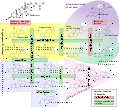
Aldosterone synthase
Encyclopedia
Aldosterone synthase is a steroid
hydroxylase cytochrome P450 oxidase
enzyme
involved in the generation of aldosterone
.
This gene encodes a member of the cytochrome P450 superfamily of enzymes. The cytochrome P450 proteins are monooxygenases that catalyze many reactions involved in drug metabolism and synthesis of cholesterol
, steroids, and other lipids. This protein is primarily expressed in the zona glomerulosa
of the adrenal cortex
. Within the cell, it localizes to the inner membrane of the mitochondria. The enzyme has steroid 18-hydroxylase activity to synthesize aldosterone
and 18-oxocortisol as well as steroid 11 beta-hydroxylase activity. Mutations in this gene cause corticosterone methyl oxidase deficiency.
It converts 11-deoxycorticosterone
to corticosterone
, to 18-hydroxycorticosterone
, and finally to aldosterone
:

Steroid
A steroid is a type of organic compound that contains a characteristic arrangement of four cycloalkane rings that are joined to each other. Examples of steroids include the dietary fat cholesterol, the sex hormones estradiol and testosterone, and the anti-inflammatory drug dexamethasone.The core...
hydroxylase cytochrome P450 oxidase
Cytochrome P450 oxidase
The cytochrome P450 superfamily is a large and diverse group of enzymes. The function of most CYP enzymes is to catalyze the oxidation of organic substances. The substrates of CYP enzymes include metabolic intermediates such as lipids and steroidal hormones, as well as xenobiotic substances...
enzyme
Enzyme
Enzymes are proteins that catalyze chemical reactions. In enzymatic reactions, the molecules at the beginning of the process, called substrates, are converted into different molecules, called products. Almost all chemical reactions in a biological cell need enzymes in order to occur at rates...
involved in the generation of aldosterone
Aldosterone
Aldosterone is a hormone that increases the reabsorption of sodium ions and water and the release of potassium in the collecting ducts and distal convoluted tubule of the kidneys' functional unit, the nephron. This increases blood volume and, therefore, increases blood pressure. Drugs that...
.
This gene encodes a member of the cytochrome P450 superfamily of enzymes. The cytochrome P450 proteins are monooxygenases that catalyze many reactions involved in drug metabolism and synthesis of cholesterol
Cholesterol
Cholesterol is a complex isoprenoid. Specifically, it is a waxy steroid of fat that is produced in the liver or intestines. It is used to produce hormones and cell membranes and is transported in the blood plasma of all mammals. It is an essential structural component of mammalian cell membranes...
, steroids, and other lipids. This protein is primarily expressed in the zona glomerulosa
Zona glomerulosa
The zona glomerulosa of the adrenal gland is the most superficial layer of the adrenal cortex, lying directly beneath the adrenal gland's capsule...
of the adrenal cortex
Adrenal cortex
Situated along the perimeter of the adrenal gland, the adrenal cortex mediates the stress response through the production of mineralocorticoids and glucocorticoids, including aldosterone and cortisol respectively. It is also a secondary site of androgen synthesis.-Layers:Notably, the reticularis in...
. Within the cell, it localizes to the inner membrane of the mitochondria. The enzyme has steroid 18-hydroxylase activity to synthesize aldosterone
Aldosterone
Aldosterone is a hormone that increases the reabsorption of sodium ions and water and the release of potassium in the collecting ducts and distal convoluted tubule of the kidneys' functional unit, the nephron. This increases blood volume and, therefore, increases blood pressure. Drugs that...
and 18-oxocortisol as well as steroid 11 beta-hydroxylase activity. Mutations in this gene cause corticosterone methyl oxidase deficiency.
It converts 11-deoxycorticosterone
11-Deoxycorticosterone
11-Deoxycorticosterone is a steroid hormone produced by the adrenal gland that possesses mineralocorticoid activity and acts as a precursor to aldosterone. As its names indicate, it can be understood as 21-hydroxy- variant of progesterone or a 11-deoxy- variant of corticosterone...
to corticosterone
Corticosterone
Corticosterone is a 21-carbon steroid hormone of the corticosteroid type produced in the cortex of the adrenal glands.-Roles:In many species, including amphibians, reptiles, rodents and birds, corticosterone is a main glucocorticoid, involved in regulation of fuel, immune reactions, and stress...
, to 18-hydroxycorticosterone
18-Hydroxycorticosterone
18-Hydroxycorticosterone is a derivative of corticosterone.It serves as an intermediate in the synthesis of aldosterone by the enzyme aldosterone synthase in the zona glomerulosa:...
, and finally to aldosterone
Aldosterone
Aldosterone is a hormone that increases the reabsorption of sodium ions and water and the release of potassium in the collecting ducts and distal convoluted tubule of the kidneys' functional unit, the nephron. This increases blood volume and, therefore, increases blood pressure. Drugs that...
:
Additional images


